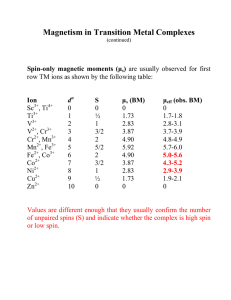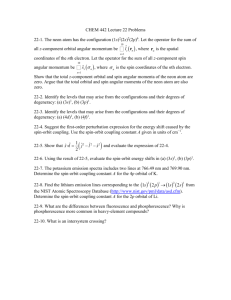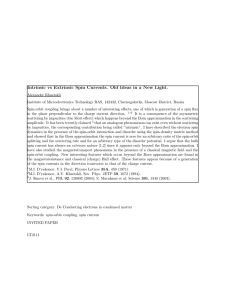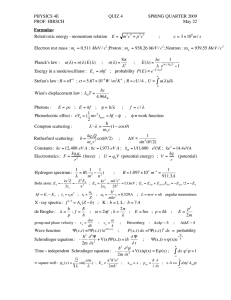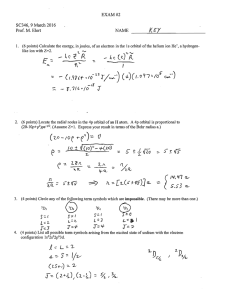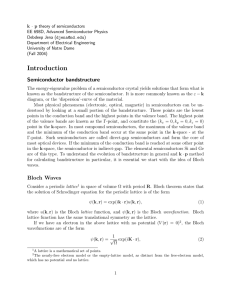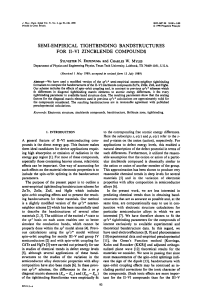6.730 Physics for Solid State Applications Lecture 23: Effective Mass Outline
advertisement
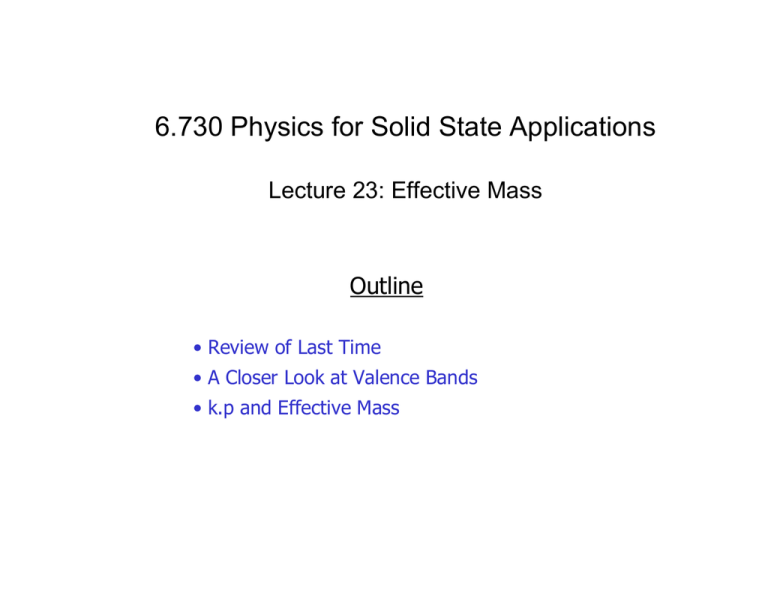
6.730 Physics for Solid State Applications Lecture 23: Effective Mass Outline • Review of Last Time • A Closer Look at Valence Bands • k.p and Effective Mass Semiclassical Equations of Motion Lets try to put these equations together…. Looks like Newton’s Law if we define the mass as follows… dynamical effective mass mass changes with k…so it changes with time according to k Dynamical Effective Mass (3D) Extension to 3-D requires some care, F and a don’t necessarily point in the same direction where Dynamical Effective Mass (3D) Ellipsoidal Energy Surfaces Fortunately, energy surfaces can often be approximate as… Motion of Valence Electrons (and Holes) electrons have negative charge valence electrons have negative mass ! Real space Vacancy ends up moving in the direction of the electric field as if it had a positive charge Hole is a quasi-particle with positive charge and positive mass… Energy Band for 1-D Lattice Single orbital, single atom basis Increasing the orbital overlap, reduces the effective mass… 2D Monatomic Square Crystals Variations with Lattice Constant W Γ X Γ W X a = 8.3 A X Γ W Increasing the orbital overlap, reduces the effective mass… 2D Monatomic Square Crystals Dispersion Relations a = 5.5 A W X Γ Γ W X a = 2.8 A X Γ W Increasing the orbital overlap, reduces the effective mass… 3D Band Structures Dispersion Relations Lighter effective mass Larger overlap between orbitals basis orbital a light mass a heavy mass a heavy mass Bandstructure of GaAs s like -orbital (k) p-like orbital What is this split-off band ? Spin-orbit Coupling Wavefunctions heavy hole charge distribution light hole charge distribution Orbital Angular Momentum Angular momentum for quantum state with l = 2: l=2 z m=2 55º 24º m=1 m=0 m = −1 m = −2 Spin-Orbit Coupling L, Bl +Zq -q -q +Zq The effective current from the motion of a nucleus in a circular orbit… …generates an effective magnetic field… Spin-Orbit Splitting µs L, Bl S +Zq -q µs +Zq -q Spin down: Low Energy Spin up: High Energy 2P3/2 2P 2P1/2 1S S L, Bl B L S J = L + S = 3/2 B L S J = L + S = 1/2 Spin-Orbit Splitting in Hydrogen L, Bl S +Zq -q µs Spin up: High Energy µs S L, Bl -q Spin down: Low Energy +Zq Angular Momentum Addition Rules Vectors Quantum Numbers Example: l = 1, s = ½ j = 3/2 j = 1/2 Spin-orbit Coupling Wavefunctions heavy hole charge distribution heavy mass (along kz) light hole charge distribution light mass (along kz) Bandstructure of GaAs Spin-orbit splitting Another Approach to Bandstructure: k.p Often it is easier to know the energies at a particular point (ex. Bandgap) than it is to measure the effecitve mass k.p is a way to relate your knowledge of energy levels at k to the effective mass…using perturbation theory Momentum and Crystal Momentum Leads us to, the action of the Hamiltonian on the Bloch amplitude…. k.p Hamiltonian (in our case q.p) If we know energies as k we can extend this to calculate energies at k+q for small q… k.p Effective Mass Second-order perturbation theory… Taylor Series expansion of energies… k.p Effective Mass k.p Effective Mass Example Lets only consider two bands (valence and conduction) and assume they are spherical… k.p Effective Mass Example Level repulsion causes bands to curve as bandgap is reduceed… Effective Mass and Bandgap Experimental Data Courtesy of Jasprit Singh; Used with Permission http://www.eecs.umich.edu/~singh/semi.html (see "Semiconductor Bandstructure")
